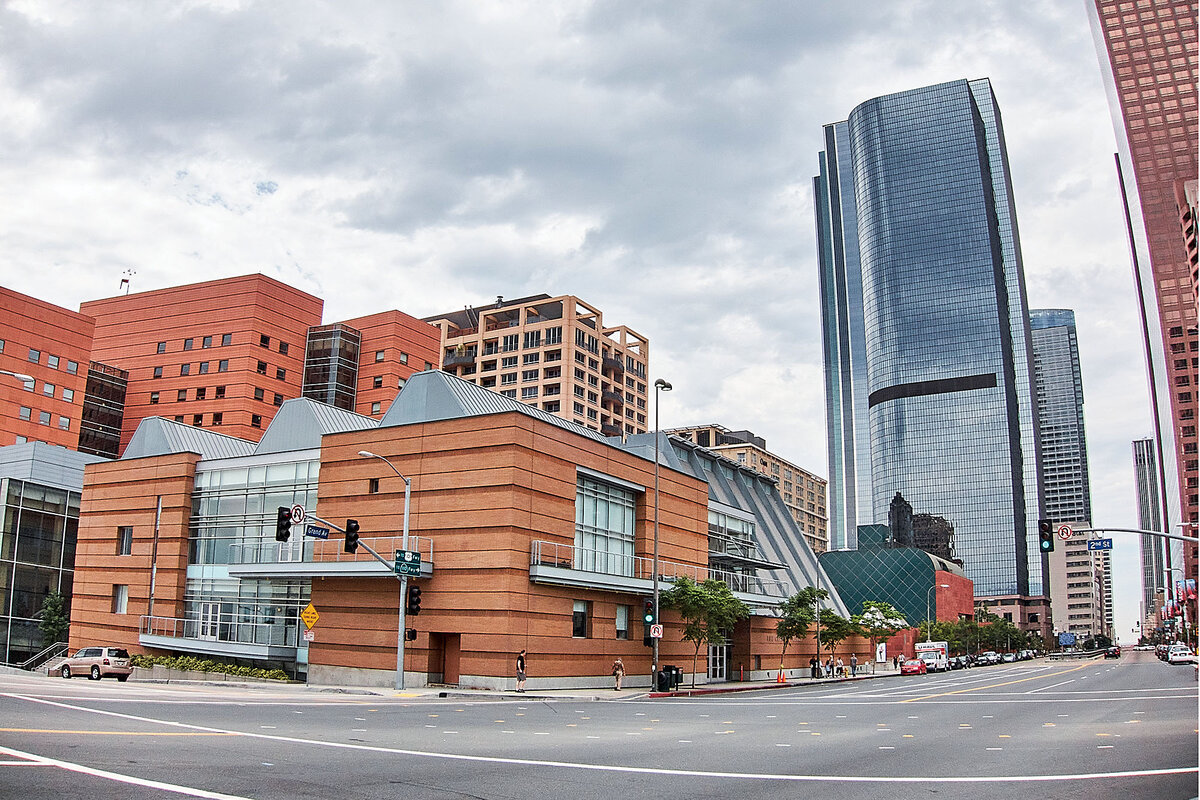From museums to monasteries, saving art amid climate change
Loading...
Museums are raising the temperature on their air-conditioning thermostats
Museums typically maintain strict controls to protect collections, but research suggests that slowly acclimating to a wider range of conditions can be safe, while reducing greenhouse gas emissions.
In Los Angeles, the Getty Center launched its Climate Impact Program, a regional initiative that helps participating institutions share knowledge about minimizing their environmental impact.
Why We Wrote This
In our progress roundup, caretakers of the world’s art treasures are changing the way they work to preserve cultural heritage, from Los Angeles to Nepal. And the “Yosemite of South America” is sold for $63 million to conservationists.
Contemporary art museums that don’t house antiques, including the Hammer Museum in LA, will test expanded temperature and humidity ranges. “Breath(e): Toward Climate and Social Justice” is their September 2024 exhibit that will explore ethical questions related to climate justice.
Other museums around the world, such as the Guggenheim Bilbao in Spain and Rijksmuseum in Amsterdam, are also working on ways to reduce energy use.
Sources: Los Angeles Times, The New York Times
Environmentalists in Chile bought 508 square miles of land for conservation
The Hacienda Pucheguin, known as the “Yosemite of South America,” is a critical ecological corridor in the Patagonia region. Its private owner, Chilean businessman Roberto Hagemann, had spent years purchasing 200 small parcels until he owned the entire stretch.
A wildlife guide, Rodrigo Condeza, learned that Mr. Hagemann planned to build a hydroelectric facility, so Mr. Condeza started the nonprofit Puelo Patagonia in 2013. The group successfully sued to stop the project, and the land was offered for sale at $150 million.
After years of the two parties being adversaries, Mr. Hagemann agreed to sell the property to Puelo Patagonia for $63 million. “A long process of mutual knowledge and respectful dialogue began, that allowed us to reach mutual understanding and respect,” Mr. Hagemann said.
Puelo Patagonia has raised $15 million for the purchase and has two years to raise the rest. Preserving the land would link a string of national parks and 4,000 miles of wilderness.
Source: The New York Times
Dancing in sync can promote feelings of belonging and togetherness
In silent discos, people dance while listening to music through headphones. Researchers in the United Kingdom and Finland used that concept and manipulated the timing of the sound to participants’ headphones to evaluate the benefits of hearing and dancing synchronously. They found that dancers preferred hearing the music in time with their partner, and also seemed to like each other more.
Previous studies point to the importance of synchronicity in social interactions. One investigation found that participants remembered people better if they danced in sync. Another study during the pandemic concluded that more social connection was facilitated by livestreamed concerts than by recorded ones. And a paper on “Zoom fatigue” suggested that video-chatting can feel exhausting, in part because of the slight lag between responses.
With 17% of Americans reporting feeling lonely in a recent Gallup poll, researchers note the importance of understanding how social connections are made and maintained. One 2020 study found that music can act as a “social surrogate” and improve well-being.
Sources: The Conversation; Gallup; Society for Education, Music and Psychology Research
Residents restore 14th-century Tibetan monasteries to adapt them to climate change
In the Upper Mustang region of Nepal, increasingly intense rainstorms are damaging the Loba people's ancient centers of Buddhist culture and religion.
Two decades ago, residents began training with art conservationists to waterproof the rammed-earth structures with round timbers, stones, and clay. The 45-person team has also restored intricate paintings and artifacts. Most of the restorers are women, who have found empowerment by learning new skills, earning a wage, and strengthening their religious practice.
Many Lobas have left the rural region for better opportunities. But “if we want to save our culture, we all need to join hands and save the monasteries because everything here spins around religion,” said Dolma Tsering, a restorer.
Source: BBC
The world produced 30% of its electricity using renewable energy last year
According to climate think tank Ember, the world must produce 60% of its electricity with renewables by 2030 to help stave off a global temperature increase of more than 1.5 degrees Celsius. In 2000, renewables made up less than 19% of the global power mix.
Solar power was the fastest-growing source of electricity for the 19th year in a row. Fossil fuels’ share in the global electricity mix fell from 64.7% in 2000 to 60.6% in 2023. Nuclear power, which produces minimal greenhouse gases but is not a renewable energy source, contributed 9% of low-carbon electricity.
Though electricity demand is set to soar after 2024, Ember predicts that fossil fuel use will continue to fall. European Union members reported that carbon emissions fell by 15.5% in 2023.
Sources: CNN, The Economist, Ember









